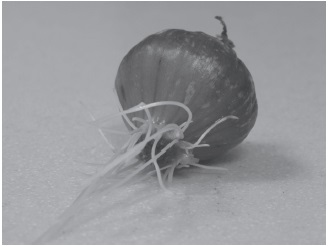Efecto citotóxico del hipoclorito de sodio (NaClO), en células apicales de raíces de cebolla (Allium cepa L.)

Resumen
El hipoclorito de sodio (NaClO), es un compuesto químico altamente tóxico y ampliamente utilizado por sus propiedades desinfectantes. Una de las especies vegetales más usadas para la detección de diferentes tipos de cambios genéticos causados por sustancias químicas es Allium cepa L. mediante la cual se hacen pruebas para la vigilancia del medio ambiente. El objetivo de esta investigación fue evaluar el efecto citotóxico del hipoclorito de sodio (NaClO) en células apicales de raíces de cebolla (Allium cepa L.). Se prepararon cinco soluciones de hipoclorito de sodio a diferentes concentraciones más una solución control con tres réplicas para cada tratamiento; se midió el crecimiento de las raíces durante 3 días, se cortaron los ápices sumergiéndose en ácido clorhídrico, posteriormente fueron teñidos con Aceto-Orceina y se observaron al microscopio; se calculó el índice mitótico (IM) y se observaron las anomalías celulares (cromosómicas). Se realizó un análisis de varianza (ANOVA) y prueba de rangos múltiples mediante el método de diferencia mínima significativa (LSD). Los resultados mostraron que no existe una diferencia estadísticamente significativa entre los tratamientos (P>0,05). La concentración donde se presentó un mayor IM fue de 1 ppm. Se evidenciaron las anomalías celulares: en anafase, evidenciando puentes entre cromosomas, hipercromasia, lesiones nucleares y rompimiento de cromosomas en anafase y metafase. Los resultados evidenciaron que Allium cepa es una especie que ofrece un modelo experimental para evaluar el efecto citotóxico, en este caso del hipoclorito de sodio, el cual generó anomalías celulares (cromosómicas) en todas las concentraciones.
Palabras clave
Índice mitótico, Metafase, Anafase, Anomalías
Citas
- Akinboro, A., K. Mohammed, S. Rathnasamy y V. Muniandy. 2011. Genotoxicity assessment of water samples from the Sungai Dua River in Pulau Pinang, Malaysia, using the Allium cepa test. Trop. Life Sci. Res. 22(2), 23-35.
- Berrocal, A.M., R.H. Blas., J. Flores y M.A. Siles. 2013. Evaluación del potencial mutagénico de biocidas (vertimec y pentacloro) sobre cebolla. Rev. Colomb. Biotecnol. 15(1), 17-27.
- Freyre, S., M. Estrada y H. Bolaños. 2009. Estudio preliminar de la citotoxicidad y la genotoxicidad de un extracto de origen vegetal conocido como palmo rosado en células meristemáticas de Allium cepa. Memorias 5(12), 12-17.
- Haq, I., S. Kumar, A. Raj, M. Lohani y G. Satyanarayana. 2017. Genotoxicity assessment of pulp and paper mill effluent before and after bacterial degradation using Allium cepa test. Chemosphere 169, 642-650. Doi: 10.1016/j.chemosphere.2016.11.101
- Hemachandra, C.K. y A. Pathiratne. 2015. Assessing toxicity of copper, cadmium and chromium levels relevant to discharge limits of industrial effluents into inland surface waters using common onion, Allium cepa bioassay. Bull. Environ. Contam. Toxicol. 94(2), 199-203. Doi: 10.1007/s00128-014-1373-8
- Hemachandra, C.K. y A. Pathiratne. 2016. Combination of physico-chemical analysis, Allium cepa test system and Oreochromis niloticus erythrocyte based comet assay/nuclear abnormalities tests for cyto-genotoxicity assessments of treated effluents discharged from textile industries. Ecotoxicol. Environ. Saf. 131, 54-64. Doi: 10.1016/j.ecoenv.2016.05.010
- Hemanth, N.K., M. Taj y S. Jagannath. 2015. Clastogenicity of sugar factory effluent using Allium assay. Res. Plant Biol. 5(6).
- Iannacone, O. y F. Alvariño. 2005. Efecto ecotoxicológico de tres metales pesados sobre el crecimiento radicular de cuatro plantas vasculares. Agric. Téc. 65(2), 198-203.
- IDEAM. 2010. Leyenda nacional de coberturas de la tierra. Metodología Corine Land Cover adaptada para Colombia escala 1:100.000. Instituto de Hidrología, Meteorología y Estudios Ambientales, Bogotá, Colombia.
- Juárez, R.P. y O.N. Lucas. 2001. Complicaciones ocasionadas por la infiltración accidental con una solución de hipoclorito de sodio. Rev. Asoc. Dental Mex. 58(5), 173-176.
- Khanna, N. y S. Sharma. 2013. Allium cepa root chromosomal aberration assay: A review. Indian J. Pharm. Biol. 1 (3), 105-119.
- Kuchy, A.H., A.A. Wani y A.N. Kamili. 2016. Cytogenetic effects of three commercially formulated pesticides on somatic and germ cells of Allium cepa. Environ. Sci. Pollut. Res. 23(7), 6895-6906. Doi: 10.1007/s11356-015-5912-6
- Llontop, L.G. y Vargas, C.D. 2016. Efecto citoreparador de Aloe vera L.“sábila” en tejidos embrionarios de Allium cepa L.“cebolla” con daño cromosómico inducido por amoxicilina. Acc Cietna 2(2), 1-10.
- Manrique, R.R., M.C. Villamizar y D.R. Quesada. 2011. Pruebas de ecotoxicidad para establecer el potencial genotóxico del hipoclorito de sodio, mediante bulbos de cebolla Allium cepa L. y semillas de lechuga Lactuca sativa L. como bioindicadores. ITECKNE 8(1), 7-14.
- Marcano, L., I. Carruyo, A. Del Campo y X. Montiel. 2004. Cytotoxicity and mode of action of maleic hydrazide in root tips of Allium cepa L. Environ. Res. 94(2), 221-226. Doi: 10.1016/S0013-9351(03)00121-X
- Marcano, L. , I. Carruyo y X. Montiel. 2001. Alteraciones citológicas inducidas por el cadmio en células meristemáticas de raíces de cebolla (Allium cepa L.). Rev. Fac. Agron. 18(4), 247-257
- Nefic, H., J. Musanovic, A. Metovic y K. Kurteshi. 2013. Chromosomal and nuclear alterations in root tip cells of Allium cepa L. induced by alprazolam. Med. Arch. 67(6), 388-392. Doi: 10.5455/medarh.2013.67.388-392
- Pandey, H., V. Kumar y B.K. Roy. 2014. Assessment of genotoxicity of some common food preservatives using Allium cepa L. as a test plant. Toxicol. Rep. 1, 300-308. Doi: 10.1016/j.toxrep.2014.06.002.
- Pathiratne, A., C.K. Hemachandra y N. De Silva. 2015. Efficacy of Allium cepa test system for screening cytotoxicity and genotoxicity of industrial effluents originated from different industrial activities. Environ. Monit. Assess. 187(12), 1-12. Doi: 10.1007/s10661-015-4954-z
- Prajitha, V. y J. Thoppil. 2016. Genotoxic and antigenotoxic potential of the aqueous leaf extracts of Amaranthus spinosus Linn. using Allium cepa assay. South Afr. J. Bot. 102, 18-25. Doi: 10.1016/j.sajb.2015.06.018
- Restrepo, R., D. Reyes, M.C. Ortiz, F.A.R. Ruiz y V.V. Kouznetsov. 2012. Aberraciones cromosomales en bulbos de cebolla Allium cepa inducidas por moléculas híbridas 4-aminoquinolínicas. Universitas Scientiarum 17(3), 253-261. Doi: 10.11144/javeriana.SC17-3.aceb
- Shrivastava, D. 2015. Cytotoxic effects of paper mill effluent on Allium cepa L. Int. J. Multidiscip. Res. Dev. 2(2), 657-661.
